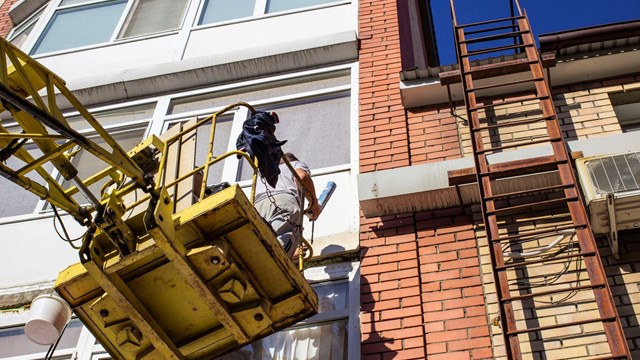
There is always work to be done on a building, whether it’s a simple lobby repair or a major capital improvement, but finding the right contractor for the job takes some work. If the vetting process is not done properly, the results could be disastrous.
Consider the following hypothetical scenario: wanting to move quickly on a capital improvement project, the board of a fictional building hastily approves a contractor without bothering to do any reference or background checks. Maybe the contractor was mentioned by a friend of a friend, or just appeared toward the top of a cursory Google search. After the project is already underway, the property manager digs around for information and discovers that the contractor’s license is expired—and although there were rave reviews posted on the contractor's website regarding the quality of his previous work for other clients, nobody at this building reached out to those clients to verify that the reviews attributed to them were true. When the property manager visits the contractor’s previous worksites, it’s clear that the contractor isn’t qualified to do what he’s been hired to do for the manager’s building.
Get Proper Insurance Coverage
And the surprises aren’t over. The manager also finds out that the contractor doesn’t have the proper insurance coverage, which leaves the building open to massive liability if something should go wrong in the course of the project. It’s looking at those small details that could be the difference between hiring a qualified contractor who can complete a job properly and has the right documentation, and hiring an inept, unqualified contractor that could cause significant trouble for the building.
“For large projects, it’s absolutely critical to make sure you’ve hired an independent expert to help draft an RFP that details the job description and what you’re going to be expecting,” says Frank Lombardi, an attorney and principal with the law firm of Goodman, Shapiro, & Lombardi, LLC, with offices in Dedham, Massachusetts and Lincoln, Rhode Island. A Request for Proposals (RFP) typically outlines the scope of the work and the specifications for the particular job.
“You want to make sure that the contract’s job description comports reasonably with the specs you had prepared, because if they don’t match, you leave yourself open to misunderstandings.” For smaller projects, like lawn maintenance, Lombardi recommends the contract outline the maintenance program in detail. “What type of lawn mower are they going to be using?” asks Lombardi. “Are they going to be using a hand-held lawn mower around the beds? Find out what you’re going to be getting, when they’re going to come by, when they won’t come by. If there’s a drought and the grass is brown, you don’t want them out there cutting. How many times do they need to pull weeds or rake leaves? This is all stuff that needs to be outlined in a contract.”
Involve the Manager
When reviewing potential contractors, having a property manager involved in the vetting process can help reduce headaches for the board. John Spagnoletti, a property manager for Mediate Management Company, Inc in Charlestown, Massachusetts, explains, “For small projects, such as hiring a general routine contractor, like a plumber or electrician who could be a dedicated resource for the association and the owners, a property manager is able to get recommendations from their colleagues, and once the property manager double checks the references and talks to potential contractors over the phone, they can use their judgment to decide if they even want to invite them to submit a proposal. And once the property manager receives three good proposals, they can review them with the board and make recommendations based on their experience. ”
Property managers wear a lot of hats, but they know that it’s best to bring in a third-party expert to advise on vetting contractors for a larger envelope project, meaning a project that affects anything to do with keeping the building water-tight. “My portfolio is primarily in Back Bay and South End, so I'm dealing with structures that were built between 1850 and 1900—so they need a lot of love and care to stay water tight,” explains Spagnoletti. “For any work that needs to be done on shingle siding, on the roofing, or on bricks, or masonry, I'm going to bring in a trusted engineer who’s an expert on what we’re trying to do and have them provide a thorough recommendation and scope of work. At that point we get buy-in from the community, not just the trustees. And once we have the ballpark number and the ownership is on board, that person will get paid to put that scope of work out to bid. We’re using their knowledge and expertise to find those contractors that have the skill level and service level to meet our needs.”
It may seem like overkill, and it may seem silly to add the additional cost of a third-party expert to the already high cost of an envelope project, but skipping these initial steps could result in years of headaches. Spagnoletti recalls a board who decided they didn’t want to pay the management company for project oversight on the installation of a new steam boiler system in a building that was built around 1910. “There was no vetting of contractors,” explains Spagnoletti. “They just invited contractors to come in and give them a price. No one on the board was an engineer or an expert at what they were trying to accomplish, and so they went with a contractor that a trustee recommended because they had put a boiler in somebody’s house. The contractor didn’t have the depth of personnel and skill needed to pull off this job in a timely manner, and once heating season came, there were all sorts of problems with the infrastructure, which is not the boiler itself, but all the parts that the boiler connects to. It was a nightmare, and they’re still digging themselves out of it.”
When it comes to selecting a contractor to do work for an HOA or condo, communication is at the top of Spagnoletti's priorities. “Especially for a contractor who I’m going to use routinely, communication is the most important piece,” explains Spagnoletti. “They have to be accessible and easy to schedule, and I need feedback after they do the job. I need to know that somebody’s going to call me or email me with an update so that I can let the board or the owners know what’s going on.”
The property manager provides a single point of contact for the contractors, which helps stop the spread of misinformation or confusion, and Lombardi recommends that the board designate a member to work with the property manager as the point person for the project. “Very often the property manager has other properties that they’re dealing with,” explains Lombardi, “so you want to have at least one board person to be the eyes on the project. You can set up a weekly or biweekly conference between all parties so that mistakes aren’t made in the performance of the contract. Especially on a major job, there should be some sort of mechanism for supervision and oversight.”
The first thing a property manager should do when starting work on a project, is to ask a lot of questions of the board to find out what exactly their expectations are for the work that needs to be done, so that they can determine if they are capable of putting together a specification that lays out the details and scope of the project. On a large project, Spagnoletti recommends using forms provided by the American Institute of Architects (AIA) that outline all of the if’s, and’s, and but’s of a large project. “These forms set up all of the general expectations to do with insurance, on-site cleanup, hazardous materials, and so on,” explains Spagnoletti. “You may not think you'll have any hazardous material issues on a job, but once you get into it you’re suddenly dealing with the removal of lead paint, and there needs to be a contingency in your contract for that. You need to know how the contractor would deal with that.”
Beware of Red Flags
Once the property manager gets the board’s approval on the specs, the next step is to send those specs out to vendors for bids. This is typically when contractors will start showing their red flags. “First of all, can they meet the expectations in terms of time?” remarks Spagnoletti. “Are they easy to schedule? How big of an organization are they? If they’re too small, they’re probably going to be stretched in bad weather and emergency situations. If they’re too large, then I’m probably going to lose touch with the person who’s responsible for the work. They need to meet the availability and communication need.”
Another red flag for Spagnoletti is billing. “I’ll ask them about invoicing,” explains Spagnoletti. “And if there’s a pause, if they’re one of those businesses that will get to it on a rainy day when they’re in the office, then it’s not going to work. If they say ‘We have an office manager that will bill you, would you like the invoice as a PDF or in the mail,’ then perfect. That's what I want to hear. It’s all about the service piece. You go with recommendations, but you also go with your gut.”
Proof of insurance and licenses should be covered in the specs sent out to vendors. “You don’t want fly-by-nighters,” remarks Lombardi. “They need to have a license to do whatever they’re doing, and they need to be insured. And you need to lay out in the contract that they’ll be responsible for ensuring that all subcontractors are properly insured, licensed and permitted. Put the onus on them. It the contract is done right, it should say that using a subcontractor who’s not properly insured is a breach of contract.” And, adds Spagnoletti, “Insurance is absolutely a requirement. I’m hiring them on behalf of the association, and to ensure the association is protected, they absolutely need to provide a certificate of insurance.”
Hiring a contractor who does not have the proper paperwork, especially insurance, could cause tremendous financial hardship to the building. “I’ve seen situations where the association can buy the insurance for the contractor and then add it to the cost of the contract price,” remarks Lombardi, “but that's just mitigating the damage. You can pay an additional premium on your master policy to cover any incidents caused by an uninsured contractor, but then your insurance company is going to say, ‘You knew they were uninsured and yet you let them do work on the property.’ They're not going to pay on that.”
Make Sure They’re Insured
To avoid these situations, make sure that the contractor shows proof of their insurance coverage. The declaration page of the contractor’s insurance policy will explain what type of coverages the contractor has, including such information as the name of the insured or insured party; the location of the property insured; the value and replacement value of property insured; the inception and expiration date of the policy period; amounts and limits of insurance coverage; deductibles; and the premium amount.
Also, the association should be listed on the insurance as an additional insured or interested party, and insurance should be explicitly dealt with in the contract. “It should be listed in the contract that it’s an express condition for payment that the contractor be insured and stay insured throughout the duration of the contract, and in some cases after the contract,” explains Lombardi. “The policy must be kept in place and upon request, written evidence of the insurance must be provided. If they can’t provide evidence of insurance you want to give them a ‘right to cure,’ which would stop all activity immediately and give them ten days to get the proper insurance. And if they can’t cure, then the contract will be terminated for failure to complete, because it’s a major, substantial condition of the contract.”
You’re Fired!
Luckily, if management has done the vetting process and thoroughly checked a potential contractor’s documentation, references and examples of their work, the odds of a problem occurring will be much lower. But what if insurance does lapse after a vendor has been contracted, for example, and work needs to be stopped?
If it is found at a later point in time that there is an issue with either insurance or licensing, the management and board’s first line of defense would be to halt the process on the job until these items are produced and verified. It’s not worth the risk involved to continue. “Once you find out their insurance has lapsed, they need to immediately get off the property,” remarks Lombardi. “They’re not supposed to be working. Somebody could break their neck, and then what are you going to do?”
Lisa Iannucci is a freelance writer and a frequent contributor to New England Condominium. Staff writer Jenn Welch also contributed to this article.






Leave a Comment